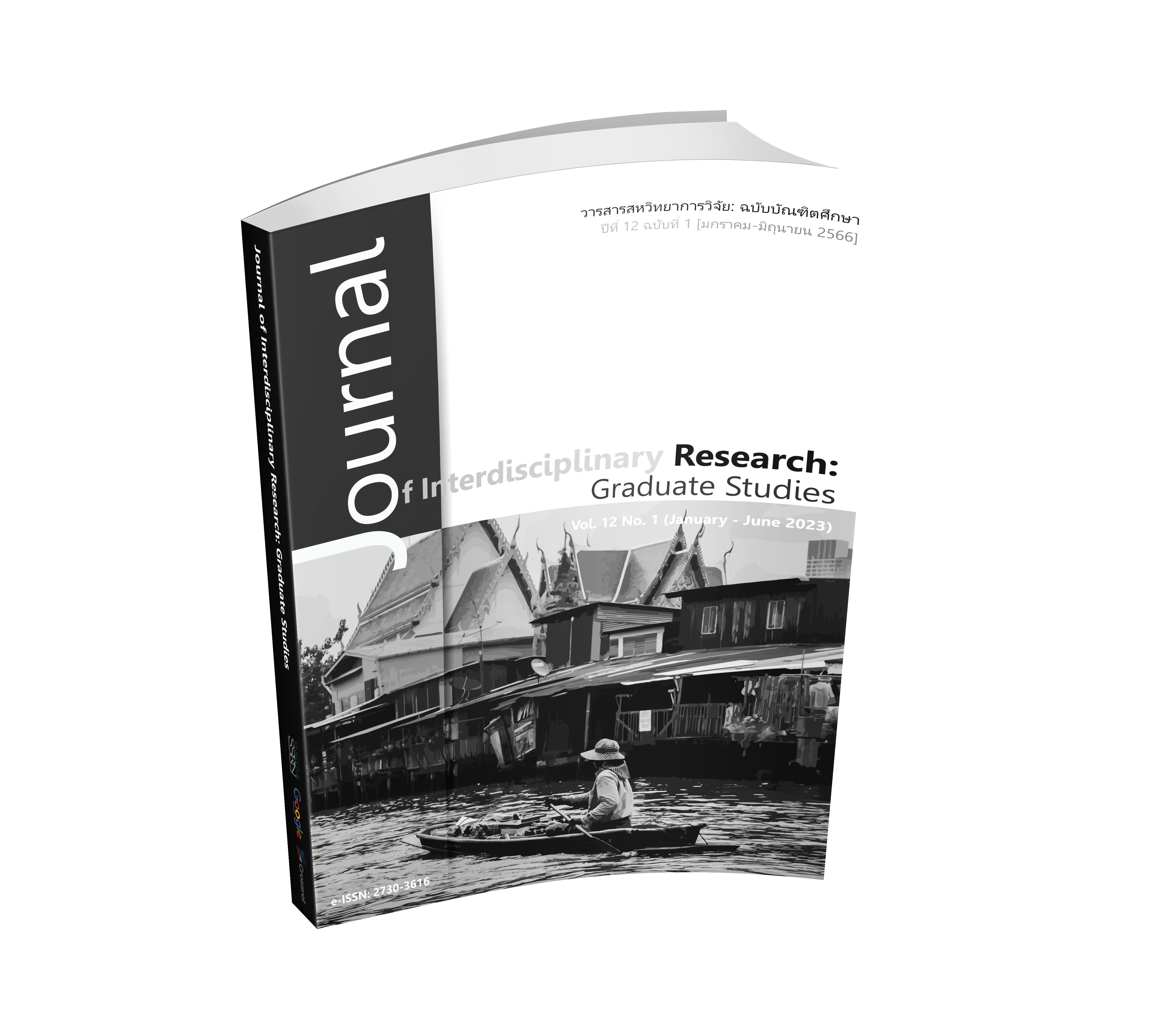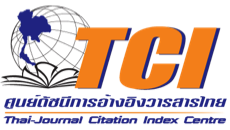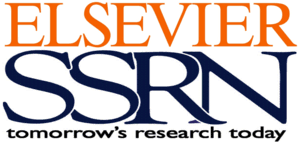การโน้มน้าวใจในบริบทของการตลาดโดยใช้ผู้มีอิทธิพล
DOI:
https://doi.org/10.14456/jirgs.2023.20คำสำคัญ:
การโน้มน้าวใจ, ผู้มีอิทธิพล, การตลาดโดยใช้ผู้มีอิทธิพลบทคัดย่อ
ปัจจุบันนักการตลาดให้ความสนใจกับการใช้อินฟลูเอนเซอร์ เพื่อโน้มน้าวใจผู้บริโภค โดยการนำเสนอผลิตภัณฑ์ผ่านช่องทางของบุคคลหรือองค์กรที่มีอิทธิพลบนสื่อสังคมออนไลน์ ที่สามารถเข้าถึงผู้บริโภคเป้าหมายได้อย่างตรงตามความสนใจของผู้บริโภค จึงนิยมใช้เป็นกลยุทธ์การตลาดดิจิทัลทั้งระยะสั้นและระยะยาวสำหรับผู้ค้าปลีก ซึ่งอินฟลูเอนเซอร์แบ่งได้ตามจำนวนผู้ติดตาม 5 ระดับ ได้แก่ 1) อินฟลูเอนเซอร์ระดับนาโน 2) อินฟลูเอนเซอร์ระดับไมโคร 3) อินฟลูเอนเซอร์ระดับกลาง 4) อินฟลูเอนเซอร์ระดับมาร์โค 5) อินฟลูเอนเซอร์ระดับเมกาหรือระดับผู้มีชื่อเสียงที่เป็นคนดังในวงการบันเทิง ซึ่งการตลาดโดยใช้ผู้มีอิทธิพล ถือเป็นเครื่องมืออันทรงพลังทางการตลาด หากการเลือกใช้อินฟลูเอนเซอร์ได้อย่างถูกวิธี ถูกเนื้อหา ถูกเวลา ถูกคน และถูกกลุ่มเป้าหมายที่ตรงกับสินค้าตามความถนัดของอินฟลูเอนเซอร์
จะสามารถผลิตเนื้อหาที่มีคุณภาพ และเป็นเครื่องมือทางการตลาดที่มีประสิทธิภาพ แต่หากจับคู่กับตราสินค้าที่ไม่ตรงตามความถนัด หรือมีการนำเสนอเนื้อหาไปในแนวทางที่โฆษณาตราสินค้ามากเกินไป อาจทำให้ผู้บริโภครู้สึกถึงความลำเอียงในการนำเสนอ จึงอาจส่งผลเสียต่อความน่าเชื่อถือของอินฟลูเอนเซอร์และต่อตราสินค้าด้วย ดังนั้นหลักการเลือกใช้อินฟลูเอนเซอร์ เพื่อโน้มน้าวใจผู้บริโภคต้อง คือเลือกใช้คนให้ถูกกับงานนั่นเอง
Downloads
เอกสารอ้างอิง
ชนินทร์ พุ่มบัณฑิต และ กมลชนก ยวดยง. (2565). ความลวงในสื่อสังคมออนไลน์. วารสารบัณฑิตศึกษา มหาวิทยาลัยราชภัฏวไลยอลงกรณ์ ในพระบรมราชูปถัมภ์, 16(3), 244-257.
ไทยรัฐออนไลน์. (2565). เปิดความหมาย "ตัวตึง" ศัพท์วัยรุ่นฮิตบนโซเชียล ไม่รู้จักระวังตกเทรนด์. สืบค้นจาก www.thairath.co.th/lifestyle/life/2530578.
วิสาขา เทียมลม. (2565). การพัฒนาการรู้เท่าทันสื่อของนักศึกษามหาวิทยาลัยสวนดุสิตภายใต้วาทกรรมเพื่อสุขภาพในโฆษณา. วารสารมนุษยศาสตร์และสังคมศาสตร์ มหาวิทยาลัยราชภัฏบ้านสมเด็จเจ้าพระยา, 16(2), 49-73.
Alboqami, H. (2023). Trust me, I'm an influencer!-Causal recipes for customer trust in artificial intelligence influencers in the retail industry. Journal of Retailing and Consumer Services, 72, 103242.
Anggraeni, N., & Nugraha, R. (2022). The Influence of Celebrity Worship On Celebrity Endorsement Towards Purchase Decisions In West Java (Case Study Blackpink At Tokopedia). FIRM Journal of Management Studies, 7(2), 156-163.
Breves, P., Liebers, N., Abt, M., & Kunze, A. (2019). The perceived fit between instagram influencers and the endorsed brand: How influencer-brand fit affects source credibility and persuasive effectiveness. Journal of Advertising Research, 59(4), 440-454.
Campbell, C., & Farrell, J. (2020). More than meets the eye: The functional components underlying influencer marketing. Business Horizons, 63(4), 469-479.
Costello, L., Dare, J., Dontje, M., Lambert, C., & Straker, L. (2022). Applying the 4Ps of social marketing to retain and engage participants in longitudinal cohort studies: generation 2 Raine study participant perspectives. BMC Medical Research Methodology, 22, 288.
Ermec, A. (2022). How Effective Are Social Media Influencers Recommendations The Effect of Message Source on Purchasing Intention and e-Word of Mouth (WOM) from a Para-Social Interaction Perspective. Journal of Business Research-Turk, 14(1), 1077-1095.
Fauzee, Z., & Dada, M. (2021). The Effect of Celebrity Endorsement on Consumer Behaviour in Klang Valley Malaysia. Electronic Journal of Business and Management, 6(4), 1-17.
Femenia-Serra, F., Gretzel, U., & Alzua-Sorzabal, A. (2022). Instagram travel influencers in #quarantine: Communicative practices and roles during COVID-19. Tourism Management, 89, 104454.
Foster, G., & Grannell, C. (2022). Essential Management Models: Tried and Tested Business Frameworks for Strategy, Customers and Growth. London: Routledge.
Friestad, M., & Wright, P. (1994). The persuasion knowledge model: how people cope with persuasion attempts. Journal of Consumer Research, 21(1), 1-31.
Geyser, W. (2023). The State of Influencer Marketing 2023: Benchmark Report. Retrieved from https://influencermarketinghub.com/influencer-marketing-benchmark-report/.
Ghorbani, Z., Kargaran, S., Saberi, A., Haghighinasab, M., Jamali, S., & Ebrahim, N. (2022). Trends and patterns in digital marketing research: bibliometric analysis. Journal of Marketing Analytics, 10, 158-172.
Hall, S. (2017). Innovative B2B Marketing. London: Kogan Page.
Hani, S., Marwan, A., & Andre, A. (2018). The effect of celebrity endorsement on consumer behavior: Case of the Lebanese jewelry industry. Arab Economic and Business Journal, 13(2), 190-196.
Jansen, N., & Hinz, O. (2022). Inferring opinion leadership from digital footprints. Journal of Business Research, 139, 1123-1137.
Janssen, L., Schouten, A., & Croes, E. (2022). Influencer advertising on Instagram: product-influencer fit and number of followers affect advertising outcomes and influencer evaluations via credibility and identification. International Journal of Advertising, 41(1), 101-127.
Kim, H. (2022). Keeping up with influencers: exploring the impact of social presence and parasocial interactions on Instagram. International Journal of Advertising, 41(3), 414-434.
Knoll, J., & Matthes, J. (2017). The effectiveness of celebrity endorsements: a meta-analysis. Journal of the Academy of Marketing Science, 45, 55-75.
Kotler, P., Keller, K., & Chernev, A. (2021). Marketing Management. 16th ed. London: Pearson Education.
Lee, J., Sudarshan, S., Sussman, K., Bright, L., & Eastin, M. (2022). Why are consumers following social media influencers on Instagram? Exploration of consumers’ motives for following influencers and the role of materialism. International Journal of Advertising, 41(1), 78-100.
Liu, N. (2022). An Analysis of Brand Spokesperson Models. Journal of Education, Humanities and Social Sciences, 4, 90-95.
Lou, C., & Yuan, S. (2019). Influencer marketing: how message value and credibility affect consumer trust of branded content on social media. Journal of Interactive Advertising, 19(1), 58-73.
Malik, A., Thapa, S., & Paswan, A. (2023). Social media influencer (SMI) as a human brand-a need fulfillment perspective. Journal of Product & Brand Management, 32(2), 173-190.
Martínez-López, F., Anaya-Sánchez, R., Giordano, M., & Lopez-Lopez, D. (2020). Behind influencer marketing: key marketing decisions and their effects on followers’ responses. Journal of Marketing Management, 36(7-8), 579-607.
Masuda, H., Han, S., & Lee, J. (2022). Impacts of influencer attributes on purchase intentions in social media influencer marketing: Mediating roles of characterizations. Technological Forecasting and Social Change, 174, 121246.
Park, J., Lee, J., Xiong, V., Septianto, F., & Seo, Y. (2021). David and Goliath: When and Why Micro-Influencers Are More Persuasive Than Mega-Influencers. Journal of Advertising, 50(5), 584-602.
Russell, C., & Rasolofoarison, D. (2017). Uncovering the power of natural endorsements: A comparison with celebrity-endorsed advertising and product placements. International Journal of Advertising, 36(5), 761-778.
Sands, S., Ferraro, C., Demsar, V., & Chandler, G. (2022). False idols: Unpacking the opportunities and challenges of falsity in the context of virtual influencers. Business Horizons, 65(6), 777-788.
Sudha, M., & Sheena, K. (2017). Impact of influencers in consumer decision process: the fashion industry. SCMS Journal of Indian Management, 14(3), 14-30.
Wielki, J. (2020). Analysis of the role of digital influencers and their impact on the functioning of the contemporary on-line promotional system and its sustainable development. Sustainability, 12(17), 7138.

ดาวน์โหลด
เผยแพร่แล้ว
รูปแบบการอ้างอิง
ฉบับ
ประเภทบทความ
สัญญาอนุญาต
ลิขสิทธิ์ (c) 2023 Authors

อนุญาตภายใต้เงื่อนไข Creative Commons Attribution-NonCommercial-NoDerivatives 4.0 International License.









.png)


